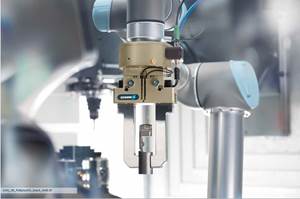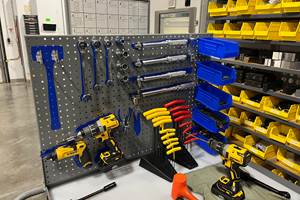Robots and Education Will Help Address Manufacturing Labor Shortage
Part 2: Presenters at a seminar on robotization discuss how collaborative robots and improved college curricula will help address the 2-million-worker gap in manufacturing over the next 10 years.
Share






An important question circling around manufacturing right now is how job shops and other producers will address the skills gap that is expected to hit the industry with a shortage of two million workers in the next ten years. Two proposed answers, not mutually exclusive, are robots and education.
At a recent seminar on robotization in manufacturing, hosted by TechSolve, Suzy Teele, head of marketing and communications at the (ARM), said, “We’ve got a real challenge in the United States where young people don’t really consider manufacturing as a viable career at the scale that we need it in order for us to grow the manufacturing sector in the United States.” This problem has led to the mission of ARM, which is to advance the use of robots in the manufacturing industry.
Ms. Teele said, “Robots are good at doing the work that humans don’t want to do. Our focus at ARM is to figure out how to help humans do the work that they want to do and not the repetitive or unsafe work that robots can do for them.” Collaborative robots (or cobots), which can work safely in conjunction with humans, represent a step toward this goal.
Imagine a job order for a large number of parts that might require a human being to repeat a series of manual tasks: removing the workpiece from the machine, placing a new one inside, opening and closing the machine door, and so on, all for hours on end. For jobs like these, cobots can essentially simulate humans, with no guarding or protection needed around the robot, freeing humans for other tasks.
For this reason, cobots will not only help address the expected worker shortage but also have a significant impact on the type of work humans perform. According to Ms. Teele, “Jobs are evolving away from highly physical labor to cerebral types of jobs, jobs where people are using computers and tablets and mobile apps to manage their environments. Robots are creating a whole other set of career paths like IT solutions architects and robotic coordinators.” The machine shop worker of the near future will take it for granted that a cobot is one of the potential resources for operating a lathe or a vertical machining center.
Meanwhile, supporting skills education will help the manufacturing industry address the upcoming worker shortage as well. “Schools that provide educational opportunities and certifications in manufacturing need funding to buy the necessary equipment, to create new programs and curriculum,” said Bob Graff, senior sales manager of STEM Education at Yaskawa America. “Students need the opportunity to touch, feel and use manufacturing equipment and become certified in it.” Implementing the necessary curriculum is an ongoing process.
Echoing Ms. Teele’s prediction that work on the shop floor will change dramatically, Mr. Graff said that Yaskawa America is increasing its efforts to support training in robot coordination. “We know what the skills are that this new class of worker will need to manage robotics. Our slant is to develop programs, curriculum and tools to help those people who want to get into robotics to start at the earliest stage possible. If we can provide a virtualized environment with the right training tools, then we can accomplish this goal.”
To this end, Yaskawa America has developed an apprenticeship program with Honda within the car-maker’s U.S. manufacturing operations that offers virtual-reality-based training. It enables students to go into a work cell that simulates techniques and processes they will need to manage robots on the shop floor. In addition, Mr. Graff said, “There’s a lot of areas in which we help students: virtualization and software simulation tools, vision, PLC, some CNC, G-code, and basic and advanced programming. We also offer a program called Train the Trainer, which essentially means we’ll train you, give you all the tools you need to go back to the classroom in your own facility and teach what you’ve learned to your students.”
As these examples illustrate, the proper technology exists and the initiative has begun to meet the labor shortage that will affect manufacturers over the next ten years.
The issue seems to be one of motivation. As cobots become integrated into machine shop work and colleges develop and implement the necessary manufacturing curricula, the ability to meet the labor shortage will improve. Young adults seeking careers, however, will need to find manufacturing attractive before they invest time and study in pursuing the field. The answer to this problem seems to follow from Ms. Teele’s assertion that manufacturing work needn’t involve exhausting physical labor, that it can be “cerebral”: the industry needs to make this fact known. If the kind of work that young people want to do these days involves more thinking than lifting, then industry leaders should emphasize the role critical/analytical skills play in manufacturing. Disseminating this idea should proceed alongside the deployment of cobots and the development of manufacturing curricula.
This is Part Two of coverage from the Robotization in Manufacturing seminar, hosted by TechSolve. Read Part One here.
Related Content
Setting Up the Building Blocks for a Digital Factory
Woodward Inc. spent over a year developing an API to connect machines to its digital factory. Caron Engineering’s MiConnect has cut most of this process while also granting the shop greater access to machine information.
Read MoreLean Approach to Automated Machine Tending Delivers Quicker Paths to Success
Almost any shop can automate at least some of its production, even in low-volume, high-mix applications. The key to getting started is finding the simplest solutions that fit your requirements. It helps to work with an automation partner that understands your needs.
Read MoreIncreasing Productivity with Digitalization and AI
Job shops are implementing automation and digitalization into workflows to eliminate set up time and increase repeatability in production.
Read MoreTranslating a Prototyping Mindset to Production
The experimental mindset that benefited BDE Manufacturing Technologies as a prototype job shop has given it an adaptable edge as a production facility.
Read MoreRead Next
Machine Shop MBA
Making Chips and 91ÊÓƵÍøÕ¾ÎÛ are teaming up for a new podcast series called Machine Shop MBA—designed to help manufacturers measure their success against the industry’s best. Through the lens of the Top Shops benchmarking program, the series explores the KPIs that set high-performing shops apart, from machine utilization and first-pass yield to employee engagement and revenue per employee.
Read MoreLast Chance! 2025 Top Shops Benchmarking Survey Still Open Through April 30
Don’t miss out! 91ÊÓƵÍøÕ¾ÎÛ's Top Shops Benchmarking Survey is still open — but not for long. This is your last chance to a receive free, customized benchmarking report that includes actionable feedback across several shopfloor and business metrics.
Read MoreAMRs Are Moving Into Manufacturing: 4 Considerations for Implementation
AMRs can provide a flexible, easy-to-use automation platform so long as manufacturers choose a suitable task and prepare their facilities.
Read More




















